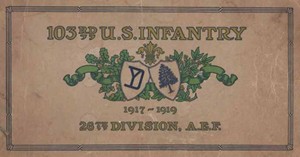
of the 26th Division of the U.S. Army
during World War I
 | The History of the 103rd Regiment of the 26th Division of the U.S. Army during World War I |
| Table of Contents | ||
| At 10:45 message from Major Hanson that Infantry could not advance. "'l`herc is much artillery and machine guns in concrete emplaeements in Riaville. Our artill··ry appar- ently does not destroy them or put them out of action. We have many wounded. Put artillery on Riaville and Tr. Haudinot, also on little patch of woods N.E. of point 9477 and keep it going." At 10:53 Major Hanson was compelled to draw back en line of Marcheville Road. Many Minnenwerfers and Machine Guns located in rear of Riaville. Artillery fire as requested until 14:00 o’el0ck, but for some reason very little fire was directed on the peifiti requested, and the Fire ceased long before 14:00 0 c on 2 At 11 :20 received word that \V0od and Bonney had been pulled back in an old Trench for the artillery preparat ion, but we did not know whether the 102nd had reached their objective anti Major Hanson did not seem to be connect ed up with them. .·\t 11 :30 o’c10ck message from Adjutant, 102nd Infantry stated that they had reached their objec- tive. At 12:45 o'clock .23 prisoners from the tittth and 82nd L.\\`. arrived at Regitnental Message Center from Marcheville. Major Hanson had difheulty in procuring the necessary artillery supports and he cemnninicated directly with the artillery commander about the matter. At 13:35 a mes— sage from Divisionvlleadqiiarters was relayed to Major Hanson that the heavy artillery_ eeuld work until 10:00 o’t-lock en rear areas. Our artillery did not atwomplish what we wanted on Riaville, and about 14:00 o’clock a heavy bombardment of Marelxeville by the enemy was observed and later two Counter attacks were reported to have been repulsed. Major Hanson was again held up in a second attempt to take ltiavillc, for the Artillery was unable to put out the Machine Guns and Minnenwe1·t`crs in the town and along Trench Haudinet. Between 16:00 and 17:30 oleloek both our own and the enemy artillery was active, but after that time all activity quiet ed down except occasional Machine Gun bursts from ltiaville and Tr. Haudinot According to Field Orders No. 133, 52nd lnfantry Brigade, Major Hanson commenced his withdrawal soon after dark, and strong ambush patrols and advanced outposts were established hy[Major Hosford to cover the withdrawal. I" E All wounded were carried back and only one dead body was left behind. Fortunately our lines of communication were not harassed during the withdrawal. K1LLi·:n ........ loflicer and 5) men \V0txonn . . . . 2 officers and 51 men Comment on this attack is unnecessary. It was the sort of sa·rifi·e attack that has to be made and is made often- times, as was this, at considerable cost. for it. is not an easy thing to go forward on n mission such as was theirs, to hold for a day, and then withdraw. The companies went at the task assigned t.hem thor- oughly. but were blocked by superior defenses. Nor did the cost end with the raid, for the enemy retaliated sharply with a gas bombardment on the front—line positions, which cost Companies l and M quite severely. These two com- panies had been holding the front for ten consecutive days: the gas attack was just one more hardship to endure. Fortunately the 3rd Battalion was relieved on the twenty- eighth and moved into support, the lst Battalion having been sent into reserve. The regiment was relieved October sixth and seventh by the 79th Division to move north of Yerdun and take part in the last great battle of the war, the Meuse-Argonne offensive. | ||
| Original Version of Page |